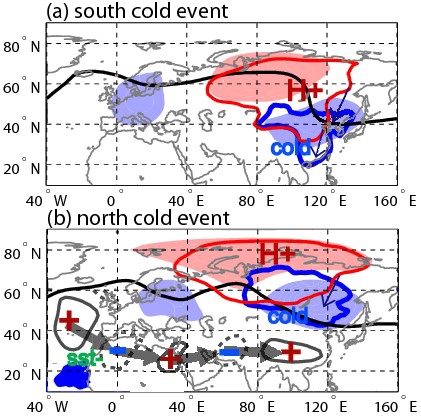
With invasion of cold air to southern China, sleet was observed, which is a rare phenomenon. Most of previous studies have been focused on strong cold events that influence the broad East Asian region, and few have studied strong cold events reaching southern China, which is far more vulnerable to cold events than northern China due to lack of needed infrastructure and experience.
The study of Dr. SONG Lei and Prof. WU Renguang from the Institute of Atmospheric Physics of the Chinese Academy of Sciences (IAP/CAS) investigated why only some but not all strong cold events can reach eastern China south of 40°N.
A comparative analysis of the two types of strong cold events reveals important differences between these two types of events in both mid-high latitude and subtropical regions.
"We found two important factors for the southward invasion of strong cold air to eastern China south of 40°N", says SONG, the first author of the study, "One is the latitudinal location of the mid-upper level wave train over the mid- to high-latitude Eurasian continent, the surface Siberian High, and the mid-tropospheric East Asian Trough. The other is a subtropical upper-level wave train emanating from the mid-latitude North Atlantic."

Schematic diagram showing features corresponding to strong (a) south and (b) north cold events. The red contour denotes the Siberian high, the blue contour denotes the cold anomaly, the black contour refers to the 500-hPa geopotential height contour at 5300 gpm, the light blue and red shadings denote negative and positive geopotential height anomalies at 500 hPa, the bold-gray arrows denote the subtropical wave train, and the blue arrows denote anomalous lower-level winds. (Image by SONG Lei)
The emergence of the subtropical wave train is related to the positive phase of the North Atlantic Oscillation. When the mid- to high-latitude wave train is located too far northward and the subtropical wave train induces an anomalous mid-tropospheric high over southern China, the East Asian Trough does not extend southwestward and the Siberian High does not expand southeastward. In such a case, the cold air mainly affects northeastern China and northern Japan.
"The invasion can only happen when the north wave train reaches mid-latitudes and the south wave train does not induce a high over southern China." WU, the corresponding author of the study, further explains when strong cold events can invade southward to southern China.

86-10-68597521 (day)
86-10-68597289 (night)

52 Sanlihe Rd., Xicheng District,
Beijing, China (100864)

